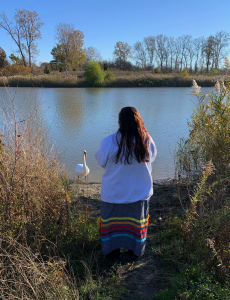Overview

Aanii/Boozhoo,
Niiganaaskwe nindizhinkaaz. Deshkaan Ziibing ndoonjbaa. Aajijaak ndoodem.
Hello, my name is Leading Light Woman. I am from Deshkaan Ziibing, otherwise known as Chippewa of the Thames First Nation. I am from the Crane clan.
This is Jaimie Kechego’s introduction that she uses and it connects us to her Anishinaabeg heritage. Jaimie is the Indigenous Curriculum and Pedagogy Project Coordinator at the University of Windsor and you will be getting to know Jaimie through this module and its accompanying videos.
This module has been designed to introduce you to the world of Indigenous pedagogies. While many areas may intersect or touch on a Western approach to education, Indigenous pedagogies focus on a holistic and relational approach to teaching and learning and a symbiotic connection to the land.
Jaimie is going to introduce you to her land at the Chippewa on the Thames First Nation and the module in this short video – Introduction to Indigenous Pedagogies (2:15).
Module Learning Outcomes
Learning Objectives
Upon successful completion of this module, participants should be able to:
- Compare and contrast key Indigenous pedagogies and braid them together into your own teaching and learning practices
- Describe important principles to consider when weaving Indigenous pedagogies into your curriculum
- Describe where UDL and Indigenous pedagogies intersect and diverge and where you can find support to explore further
Learning Activities and Assessments
- Reflect questions throughout the module
- Application activity
Time Commitment
Approximately 180 minutes
Introduction
We will be modelling some of the pedagogies rather than writing about them throughout this module. This will occur through text, images, and storytelling videos. No conversation about inclusivity and learning in this land we call Canada would be complete unless Indigenous perspectives are also involved, so we are bringing a very small journey into that world for you to experience. Further, “decolonization” and “indigenization” are large and important topics, and we won’t be covering them in this module. A good place to start to learn on the topic is in the Pulling Together: A Guide for Curriculum Developers open educational resources or other materials in the series or seek out other sources of information found at the end of the module.
Some important considerations when completing this module:
- This is not an exhaustive representation of all Indigenous pedagogies as we cannot possibly cover all within a short module. Nor does the module cover all the various Indigenous People’s viewpoints and perspectives. According to Statistics Canada (2021), “The Canadian Constitution recognizes three groups of Indigenous peoples: First Nations, Inuit, and Métis. These are three distinct peoples with unique histories, languages, cultural practices and spiritual beliefs”. Therefore, we are providing an introduction to common teaching and learning concepts and encourage you to seek more knowledge, permissions, and conversations with local Indigenous Peoples to make it relevant to your situation and discipline.
- Some topics or approaches may trigger some discomfort or some excitement when learning new practices based on Indigenous traditional knowledge. Please seek help if you get overwhelmed.
Module Inquiry / Values
- Describe the holistic (emotional, spiritual, physical and intellectual) and personal approaches used in Indigenous pedagogies
- Embrace the spiritual, secular, and sacred components woven throughout the teachings
- Develop appreciation and respect for intergenerational and inter-relational learning
- Commit to experiential, land-based, and place-based learning as a vital and sustainable approach to teaching and learning for your learners
Overview of Key Indigenous Pedagogies
The following characteristics describe Indigenous pedagogies which we will explore in more detail:
How is Indigenous knowledge known (epistemologies) and how it is taught (pedagogies)?
A couple of definitions from the Pulling Together: A Guide for Curriculum Developers (Antoine et al, 2018) resource will help to position the topics that follow:
Indigenous Epistemologies |
Indigenous Pedagogies |
Theory of knowledge that is based on Indigenous perspectives, such as
The emotional, spiritual, cognitive, and physical dimensions of knowledge are common in Indigenous epistemologies. |
The method and practices of teaching that focus on:
|
References:
Antoine, A., Mason, R., Mason, R., Palahicky, S., & Rodriguez de France, C. (2018). Pulling together: A guide for curriculum developers. BCcampus. https://opentextbc.ca/indigenizationcurriculumdevelopers/
Indigenous Services Canada. (2021, Nov 3). Annual report to Parliament 2020, Indigenous Services Canada. Retrieved Jan 4, 2021, from https://www.sac-isc.gc.ca/eng/1602010609492/1602010631711

